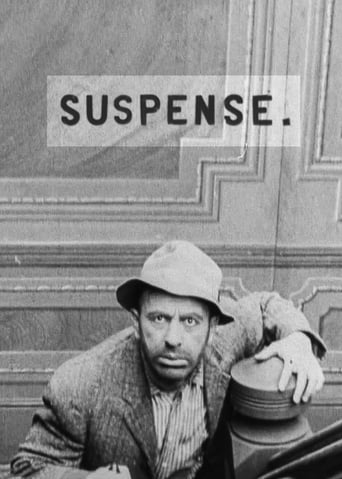Hitchcoc
The title tells it all. A woman and her child are alone at the house because the hired help decides to take off. Her husband is at work. She realizes there is a man outside, a hobo. He gets into the house after she has called her husband. Then we have the classic "Will he get there" plot. He steals a car and leaves he driver, who immediately gets the police involved. This was directed by a woman and for a short film is edited very well and tells a convincing story.
MisterWhiplash
Sometimes the simple approach works best, and in 1913 filmmakers were still working out the basics of what this thing called film-MAKING was and is all about. Suspense is the kind of movie that was at or around the same time of Griffith, who pioneered the use of inter-cutting between different stories. With this film, co-directed by Lois Webber (called in the film places I just looked up the first American woman director), it's a story in a quick ten minutes: after the maid decides to walk out on a mother and her infant (the husband is off at work), a "Pursuer" (aka a vagrant, a bum, a good old criminal) sees the maid leave and prowls around the house until he sees it's time to break in.The title comes from what Hitchcock often described what suspense in cinema is all about: following what happens when we can see one story unfolding and another is taking place concurrently, but the bomb doesn't go off right away - it needs to take time, and the suspense all comes from when it will go off. In this case the bomb is the Pursuer, acting more like a wild animal than a rational human being (Douglas Gerrard as the Pursuer fills the role to the point of being terrifying most of all in the few close-ups that happen, which is just enough), and it's only a matter of time before it goes off.There's so much creative direction here from Weber and Phillips Smalley, and it's impressive still today as a mini-masterpiece of filmmaking, where the structure is air-tight and yet there's enough time for set-up (showing this mother, her child, and the husband off in his office, and then the prowler as he goes up the property and through the windows), and then what happens when things escalate. All the shots matter, and yet there's a lot of experimenting with form: there's a moment where you see three subjects - the wife, the husband, the pursuer - all in the frame, and separated by triangles showing what's going on (this shows us why the phone line gets cut at a crucial moment). And even something as simple as a shot through a "keyhole" seems revolutionary for the time.For younger people who have been raised on online video it may not seem like much. It even may be just slightly contrived around the fact that the husband's car is stolen literally under his nose. But that adds to the 'what will happen next', and the filmmakers keep the pace so quick and tight that there's barely a moment to think about the particulars. When you see an overhead shot of the Pursuer coming up to the door, it's quite terrifying just by the framing and how the actor fills it all like some hobo-demon. The fact that it comes from a woman director doesn't matter in a way - clearly Weber could direct with the best of any of her counterparts, including Griffith (and this is supposedly a remake of one of his own films, with some added visual tricks). It feels like such a simple story and yet so universal that it should probably be shown to any film student first day of class to say 'THIS is how it's done.'
Zbigniew_Krycsiwiki
Looking through keyhole for the first time in cinema history? Servant, apparently bored in the "lonesome place", picks up and leaves, leaving the wife and infant child home alone. Hobo, lurking outside, sees the servant leaving and breaks into home.Prism in centre of the frame, with man in it, talking to wife on telephone, in upper left corner, hobo sneaking in house in upper right corner. Later, man in centre of prism, wifey in upper left, hobo sneaking into house in top right as he cuts the phone line. He chops down and punches down the door, while wifey frantically calls hubby to come to the rescue.Noticeably filmed out of doors, as wind picks up and blows paperwork off desk, several early uses of mirror reflections, all to good effect. Good trick shot of a guy being hit by a car during pursuit.
tavm
This silent drama short was directed by Phillips Smalley and his wife Lois Weber who also appears. She plays a woman with a baby left alone in the house after her maid leaves a notice of her quitting. A wandering tramp finds the key under the outside mat left over by the maid. When the mother realizes her situation she calls her husband at work who rushes in a stolen car with police and car's owner in pursuit...While melodramatic, this was quite an exciting thriller for the early days of cinema that still provides some moments today. And how fascinating to see one of the earliest uses of the split-screen in seeing various actions happening simultaneously which in this instance is in three ways in what was called the triptych. So on that note, I highly recommend Suspense.

